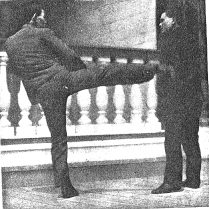 Driving
the point of the toe into the kidneys. He could do this under a boxer's
guard.
Driving
the point of the toe into the kidneys. He could do this under a boxer's
guard.
By Robert EdgrenThe Fearful Art of Jiu Jitsu
Reprinted from Outing, December 1905, 322-328. Edited by Joseph Svinth and W. J. Long. Annotations copyright © 2000 all rights reserved.
Actual conflicts between Japanese jiu jitsu experts and American wrestlers or boxers have been few. Whether the Japanese or the American methods of self-defense excel is an interesting question, but just now the answer can be based upon such small data as we have, and guesswork.
A short time ago [April 1905, to be precise], in New York City, a jiu jitsu man from the ancient empire of Japan was pitted against an American wrestler. The Japanese was [Katsukuma] Higashi, the most famous exponent of his art in America. [EN1] The wrestler was George Bothner, formerly American lightweight champion on the mat, and without a doubt the most clever and versatile wrestler in the country.
 Driving
the point of the toe into the kidneys. He could do this under a boxer's
guard.
Driving
the point of the toe into the kidneys. He could do this under a boxer's
guard.
It was a curious match -- a novelty -- and it drew a great crowd. Most of the people who came expected to see the little brown man break Bothner's bones. [EN2] They were disappointed. If there was any jiu jitsu at all used in the match it was of that milder form taught by the professors of judo. In fact the contest was anything but a test of the Japanese art, for I afterward learned that Higashi had been made to agree not to use any tricks that might do the wrestler bodily harm. [EN3] Jiu jitsu is purely a collection of grips and twists and kicks and blows designed to injure and incapacitate an opponent. It was originated three hundred years ago (not two thousand, as some say) by one of the Japanese noblemen known as Samurai. These gentlemen usually carried two swords and a small dagger. It happened now and then that one was waylaid while his cutlery was beyond reach. Jiu jitsu was intended to enable an entirely unarmed man to defend himself successfully against armed men. Naturally the unarmed man would not be careful to observe the ancient English rules of a "fair stand-up fight." Having in mind the fact that he must either incapacitate his enemies or be killed on the spot, he would use effective tricks that are forbidden in our boxing and wrestling contests. This is the reason that American athletes are inclined to speak slightingly of the "foul" manner of self-defense used by the Japanese. Of course jiu jitsu isn't used for the purposes of athletic competition. The nature of the thing makes that impossible. It is fighting of the most desperate kind, used by a people that have never indulged in fighting with any other purpose than to kill. The greater number of jiu jitsu tricks are called "dangerous tricks" by the Japanese, and all are intended to cause severe injuries or death. There are simple artifices, too, used to gain an advantage without injuring a rival seriously, but they are few.
So when Higashi had to prune away everything that might hurt Bothner he was forced to fall back upon ordinary wrestling tactics, with a few simple variations of a Japanese sort. Even so the little Japanese (he was outweighed twenty pounds) made a great impression on the spectators. He wrestled three hours, always on the aggressive. Perhaps the Japanese system of training gave him the wonderful endurance that brought him fresh and strong to the finish. Perhaps it was the constitutional wiriness of his hard marching and hard fighting race. [EN4]
Among the things that were agreed to in the articles governing the match [in New York on April 6, 1905] was that flying falls were to count. Twice Higashi threw Bothner clear over his head, dropping him flat upon his shoulders and neck. The referee [James J. O'Brien of Philadelphia] didn't see the fall on either occasion. [Not too surprising, since he was also Bothner's jujutsu coach.] One at least that was scored against Higashi was allowed when the Japanese athlete's shoulders had not come within six inches of the mat. The most important part of the training in jiu jitsu teaches the student to control his temper under any and all circumstances. The novice is thoroughly tested for over a year in this matter before he is allowed to learn any of the serious tricks. How effective the training was Higashi showed, for in spite of the prejudice and unfairness that met him on every side, he smiled and maintained his good humor to the end of the contest.
The contestants were dressed in short kimonos [sic; uwagi is meant] and tights. The kimono was a provision of Higashi's, and of course it placed Bothner, the wrestler, under a disadvantage. It was like a canvas jacket. The jiu jitsu being a purely practical art, Higashi argued that no man would find himself in a sudden predicament, demanding defensive tactics, while stripped to the waist like a wrestler. He would have his coat on, and the kimono took the place of the coat. Bothner, at the beginning of the bout, grasped his kimono tightly at the neck with both hands, and held on, putting his forehead on the floor in approved wrestling fashion. Higashi, his joint-twisting tricks, kicks and blows barred, depended upon getting a neck grip on the kimono, instead of a half-nelson or an American hammer lock.
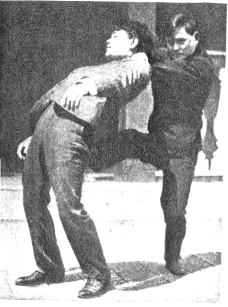 Breaking the back with a kick after getting a strangle hold on the coat
collar.
Breaking the back with a kick after getting a strangle hold on the coat
collar.
The little brown man was surprised when Bothner did the one thing that might act as a complete foil for his attack. Afterward it came out that the American, with true Yankee foxiness, had slyly secured the services of another jiu jitsu man [O'Brien] before the match, and had learned from him a complete defense against the simple grips that were allowed to Higashi under the agreement.
The outcome of the Bothner-Higashi match [Bothner won] is no argument against the Japanese fighting style. Jiu jitsu includes scores of tricks that kill or maim. If Higashi could have been allowed to use any of these the match wouldn't have lasted a minute. There are tricks to meet any emergency. One that Higashi showed me a few days ago was used when an unarmed man was attacked by one with a sword. Part of the combination of movements involved the losing of an arm by the unarmed fighter, in guarding against the swordsman's cut or thrust. But after that, losing his left or right hand at the wrist, he could instantly gain a one-armed strangle hold on his opponent that would end the contest. "In the old hand-to-hand fighting days Japanese noblemen used these tricks on the battlefield." [EN5]
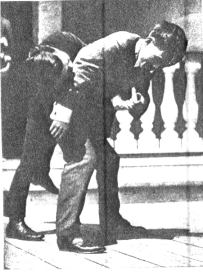 After being back-heeled, Higashi falls backward, twists and comes up with
a wrist-breaking hold.
After being back-heeled, Higashi falls backward, twists and comes up with
a wrist-breaking hold.
I was talking with [heavyweight boxing champion Jim] Jeffries about the Japanese art. Very many of the jiu jitsu tricks start with giving the opponent an apparent advantage. For instance the Japanese attacked will purposely go to the ground when struck, although he is uninjured.
"Why," exclaimed the big boxer, "he'd be whipped right there. In a fight of the rough-house variety I could kick his head off as soon as he went down."
Exactly! That's what any boxer would think. [EN6]
But as a matter of fact he'd only be playing the Jap's [sic] own game. He would not know how to use his toes and heels, while the Japanese would have a score of blocks and counter attacks. The most effective fighting is done on the ground. If Jeffries, or any other good fighter, were reckless enough to try to kick or closely approach one of these Japanese experts while the latter lay on his back the fight would end immediately. The only thing to do would be to wait for him to get up again.
There are several ways, while lying on the ground, of disabling the man who is on his feet. The quickest and most effective, I think, is a simple trick that breaks the knee. [EN7] Higashi has shown that one, many a time. No matter how quickly the boxer moves about, once within reach the lightning-fast little Jap would have him. He lies on his back, with both legs drawn up. In that position he can turn swiftly to face any direction. The boxer's left [lead] foot comes within reach. Instantly Higashi's foot -- either one -- slips out, quick as the strike of a rattlesnake. His toes hook behind the ankle of his rival with a grip that holds like the frog in a railroad track. [EN8] In the same tenth of a second his other leg shoots out like a piston. The heel strikes just below his opponent's knee, with all the force of thigh and back behind it. The foot imprisoned, the weight of the body acting as a fulcrum above, the knee alone can give way, and it snaps like a clay pipe.
Boxers have told me that these tricks are impracticable -- that they could not be played on a man who was moving shiftily about on his feet. I have been an interested student of boxing myself for several years, and I am satisfied that Higashi could catch this one hold on anyone who came near him while he was lying on the ground, and that he could break [e.g., bend] Jeffries' knee as easily as he could a lightweight's.
 Higashi strangling Nishimura with a cross-hold on the coat collar.
Higashi strangling Nishimura with a cross-hold on the coat collar.
Any man who could whip Sailor Tom Sharkey in his best days would have to use effective measures. Yet one of these little brown men, probably, for he was a low-class Jap, one who had only a superficial knowledge of the game, once knocked the mighty mariner out in less than ten seconds.
It happened in one of Nippon's seaports. Sharkey was a wild, rough sailor then, and fond of fighting, whenever he could find an excuse for it.
He and his mates made a practice of going ashore, taking in the town, and then whipping two or three men as a parting pleasure before going aboard again.
On this particular occasion Sharkey got into trouble. Here is his own story, exactly as he told it to me:
"We were just going ashore to see the town. There were two other sailors and me, and we always used to get into fights together. We hired three rickshaws at the wharf, each wheeled by a Jap. When we started I thought it would be a lot of fun to jump up and down and jerk the handles out of his grip. I took one hop. The whole bottom of the rickshaw dropped out and left me standing on the ground. The little Jap stood there holding the broken handles in his hands, and I had to laugh at the funny look on his face. The other fellows were ahead. I got out of the wreck and started after them. The Jap ran after me, and I turned around and made a swing at him. I missed. Then he ducked in close to me and hooked his toe into my side. [That is, he did a roundhouse kick.] I fell right down on my face. If the others hadn't come running back I would have been killed. They picked me up. Then the Japs piled out and beat the life nearly out of us with bamboo poles before they could drag me back to the wharf."Why shouldn't jiu jitsu be effective? Students of the art are trained for years, and they work harder than any American college man does at his tasks. Every college and school in Japan teaches the rudimentary tricks to both male and female students. [EN9] For three hundred years thousands of men have been inventing and perfecting systems of defense and offense. Beside it boxing is only a sporadic growth like the moss on an oak tree. Jiu jitsu is fighting, as deadly as that of the sword.
Boxing was fighting two thousand years ago, when men wore the brass-banded cestus on their hands, and broke arms and skulls with their blows. But modern boxing, with gloves or bare fists, is a milder form of exercise. It was first encouraged in England, for the express purpose of teaching quarrelsome people to spend their spite in "a fair stand-up fist fight," instead of using the deadly knife like the Latins. [EN10]
All of the defensive tricks in jiu jitsu are really offensive, as they must be when the one purpose of the fighter is to disable his enemy. A favorite method is to fall before an attack, catching at the same time a grip that will bring your opponent with you, and as you fall turning it into some deadly combination. It is with one of these that Higashi threw Bothner twice. But he used only the harmless combination. Taking a grip on the lapels of Bothner's kimono and working about until the wrestler was balanced just right, Higashi fell backward. Bothner fell on top of him. Higashi's left foot came up against the wrestler's stomach, and a powerful kick threw him up into the air, to hover helplessly and come down head first. But Higashi held the grip on the lapels and turned Bothner so that he came down flat on his shoulders. He could have given a certain snap to the swing, like the cracking of a whip, that would have driven the wrestler head first against the floor – a neck-breaking fall.
Many of the Japanese tricks are in the line of kicking. One of them, that would be useful against a boxer, involves the breaking of a knee. The Jap jumps in quickly. Apparently he is wide open for a blow, but his body twists and drops to the ground. At the same time his legs slip forward into the same ankle grip and knee kick that I described a moment ago. It is like the ground work, but is aggressive and sudden. A boxer seeing his enemy coming in with no guard would naturally whip over one hand or the other. The blow would glance, if it landed at all, and then the end of the fight would come.
If the boxer stepped away warily he would escape. But any strong man can take blow after blow without being knocked out. Boxing is full of clinches. The first clinch would date the victory of the jiu jitsu man.
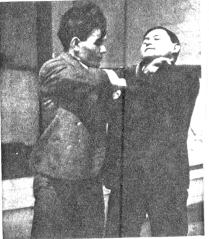 Crushing the throat with pressure of the wrist -- the leverage being obtained
by a hold on the coat lapel.
Crushing the throat with pressure of the wrist -- the leverage being obtained
by a hold on the coat lapel.
Of course with a boxer, fast, clever and gigantic in strength like Jeffries, pitted against a little fellow like one of these Japanese, the ending might be different. Jeffries hits quickly and at long range. One of his blows would turn a light man half a dozen summersaults. I asked Higashi what he would do if he should happen to mix matters up with Jeffries.
"That would be foolish to talk about," said Higashi. "Jeffries is so tremendous that he is not like an ordinary man. I could easily vanquish any man as big as he, but without the same experience in fighting. But Jeffries is so big and quick. I would weigh only one-half as much. I would use nothing but kicking tricks against him. I would either jump high and direct the kicks to vital points about the head or try to slip to the ground under his guard. There he couldn't hurt me, for he can't hit down so low, and if I could get near enough to reach his ankles I could break the shins or the knees with my tricks. From the ground too I could kick upward to the vital parts of the body [e.g., the groin]. If he tried to kick me I could wish nothing better, for it is very easy to make a strong man break his own bones. Many of the fatal tricks make a strong man injure himself. I could not use the strangling holds very well against Jeffries, for he is so big. It would be hard to twist or break his arms, for the same reason. But there are many points about the body and head and legs that could be attacked with kicking tricks. If it were a matter of life and death a man can fight with one arm, but he is helpless when his legs are broken."
I have used Higashi so much in illustration for the reason that he is the best exponent of the Japanese art in America. In England they have had more experience of the Japanese fighting style than we have here.
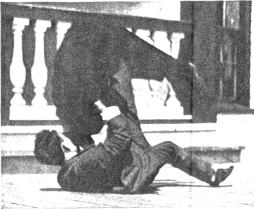 Higashi falling and throwing Nishimura over his head by jerking him forward
and kicking him in the stomach. In this way he threw Bothner, the American
wrestler.
Higashi falling and throwing Nishimura over his head by jerking him forward
and kicking him in the stomach. In this way he threw Bothner, the American
wrestler.
There, for instance was Yukio Tani, a diminutive Japanese from the same school that Higashi attended in Japan, and a man of the same grade. [EN11] Tani is of about a hundred and ten pounds weight. He landed in England a couple of years ago [1899], and at once began the practice of his art, trimmed down to suit the requirements of English law, which does not encourage bone breaking.
Tani first appeared on the stage in a provincial music hall. He challenged any wrestler to meet him, and agreed to forfeit five pounds [US $25] to any man whom he could not overcome within a certain time. He was such a small, inoffensive fellow that the local disciples of the wrestling fad flocked to the hall at the next performance. Half a dozen were chosen for his initial endeavor. Tani explained that he would try not to injure anyone, but if the wrestler became helpless and was unable to call out, he must signify his defeat by knocking on the floor or on Tani's body with his hand.
The little Jap disposed of that first job lot as fast as they were brought on. He used only the twisting and strangling holds, and every wrestler was glad to submit before the grips were pressed to the limit. Then Tani began a triumphal tour. Nightly he gave out his challenge. During the course of several months he vanquished an army of wrestlers, and none of them ever managed to get the best of him. Ordinary shoulder falls did not count. The test was the final submission of one of the parties to the match.
Then [in October 1904] there came to London one Tarro Myaki [sic; Taro Miyake is meant], another Japanese expert. He was exactly like Tani, wiry and strong and skillful, but twenty pounds heavier. One night [December 23, 1904] when Tani challenged from the stage of the Tivoli [music hall], Myaki suddenly stepped from a box and leaped across the footlights. They struggled hard, and in a few moments Tani, met with equal skill and outclassed in strength, was beaten. [EN12]
The feats of Tani and Myaki in England show that even with the most warlike parts eliminated jiu jitsu will enable a well-trained expert to defeat a wrestler in a finish contest.
A match between the jiu jitsu expert and the wielder of boxing gloves or bare fists would be impossible. The jiu jitsu man would have to leave out nine-tenths of the effectiveness of his art, for the law doesn't countenance the killing or maiming of men. Some time, perhaps, a boxer will attack a real expert in the Japanese art, and carry the attack to such an extent that the Japanese will be forced to defend himself with all his knowledge of his own peculiar game. Then we will be able to draw a certain and definite comparison between the different styles of self-defense. But as for myself, I would not like to be the boxer.
EN1. Remember that Edgren is talking about contemporary fame; to posterity, better-known judoka then resident in New York City included Tsunejiro Tomita (an early student of judo founder Jigoro Kano) and Esai Maeda (the future founder of Gracie jujitsu).
EN2. Higashi's boosters included the New York sportswriters Irving Hancock and Robert Edgren, thus their readers came expecting superhuman feats. Unfortunately Higashi was either on the payroll (always a possibility in professional wrestling) or not as good as claimed; certainly the Seattle judoka Tokugoro Ito rarely had trouble strangling competent wrestlers into submission. For example, on September 3, 1909, Portus Baxter of the Seattle Post-Intelligencer had this to say about Ito's match with Eddie Robinson of San Francisco:
Ito locked his legs around the white man and began to 'scissor' him. Next he got a strangle hold, using Robinson's neck cloth as a tourniquet, and slowly forced the American into submission by the process of strangulation. The time was 10 minutes 55 seconds.
The second bout lasted three minutes… Again the Japanese tied on the tourniquet and Robinson's face went red and then black. He was helped to his corner, and in spite of the vicious fight they had gone through, the Japanese was the first to assist Robinson. That was a piece of real sportsmanship.
"In each bout Bothner went as close to the mat as he could and there he hung. He was expected to use catch-as-catch-can methods, but despite the appeals of spectators to get up and wrestle 'like a man' he displayed a new line of shoving and burrowing tactics which can be described only as push-as-push-can. To this new and inactive style of 'push' wrestling he devoted himself so assiduously as to make a real contest all but impossible.
"It had been agreed that a flying fall should count. I made two in succession, each time hurling Mr. Bothner over my head. My judge claimed the falls for me, but they were disallowed, although explicitly provided for in the final agreement. Then I secured another well-known jiu-jitsu fall by folding my opponent's arms around me and going over backward, landing him under me on his back. All of these falls are allowed under the Japanese rules, as they constitute a real, not a constructive victory."
Higashi also makes the charge that he was tricked out of the choice of referee. "I knew perfectly well that no American referee would be capable of giving an intelligent interpretation of the Japanese rules," he says. "There is but one American, so far as I know, who is familiar with both Japanese and American rules – H. Irving Hancock. It was agreed between Mr. Bothner's manager and myself that Mr. Hancock should referee the contest. At the last moment Bothner's manager informed me that Mr. Hancock was to act only as my judge. Thus again I was tricked out of the possibility of a fair decision. Of the referee who served I will not say more than that he was wholly ignorant of the spirit of the rules under which it had been agreed to hold the contest." [Hancock was Higashi's promoter, so no fairer a judge than O'Brien.]
Whatever the merits of this dispute may be, it ought to be said in favor of Bothner that he displayed the true sportsmanlike spirit in consenting to wear the Japanese costume during the match. The thick, loose jacket plainly bothered him, and in order to weaken his opponent's hold about his neck Bothner frequently defended himself with but one hand, while with the other he tried to keep the jacket from rising up to his neck. [This is the trick O'Brien had taught Bothner to prevent strangle holds.] This in itself was a disadvantage to him. The entire affair illustrates the difficulty of arranging a satisfactory match between two opponents whose respective methods are so diametrically different.
EN5. In practice, either shock or blood loss would cause most stranglers to pass out at least as quickly as the swordsman. As for Higashi's own superhuman powers, well, a few months later in Paris, France, Higashi was unable or unwilling to finish a judo match with Yukio Tani after the latter accidentally kicked him in the groin.
EN6. Before his loss to Bothner, Higashi’s ambitions had included arranging a match with Jeffries, then the world’s heavyweight boxing champion. Jeffries declined Higashi’s offer, saying, "I’d be a nice one if I should hit a little fellow like that." (New York World, March 27, 1905, 8)
EN7. In the context of this paragraph, it is not certain whether Edgren's use of the word "break" refers to a traumatic injury to the patella or simply a bent joint. See, for example, the dictionary definition of "to break one's wrists," which describes the way that the wrists move while one swings a bat or club. Certainly the technique described is more likely to cause someone to fall than to suffer a greenstick fracture.
EN8. This frog is not some terrified web-footed amphibian, but a device permitting the wheels running over one rail to cross an intersecting track.
EN9. This statement was not true in 1905. For example, the Kodokan did not officially open its women's dojo until 1926. Furthermore, a breakdown prepared by Sakujiro Yokoyama in 1911, the year that the Ministry of Education put judo into Japanese physical education classes, revealed that the Kodokan had two men ranked 7-dan, three ranked 6-dan, six ranked 5-dan, thirty ranked 4-dan, 120 ranked 3-dan, 300 ranked 2-dan, and 750 ranked 1-dan. Thus it is hyperbole to say that every Japanese schoolboy was a judo master. The source for membership data is an unpublished 1983 manuscript by Paul Nurse entitled "The Beginnings of Kodokan Judo: 1882-1938."
EN10. The allusion is to St. Bernard, a thirteenth century monk who encouraged Italian youths to fight with knuckles instead of knives during Carnival brawls.
EN11. The editors are unaware of any evidence to show that Tani trained in Tsutsumi Hozan Ryu jujutsu, as Higashi had. As for their levels of mastery, in December 1920 Jigoro Kano promoted Tani to 2-dan, which implies that in 1905 neither he nor Higashi was ranked very highly in Japan. For more about Tani's early career, see Graham Noble, "An Introduction to W. Barton-Wright (1860-1951) and the Ecclectic [sic] Art of Bartitsu," Journal of Asian Martial Arts, 8:2 (1999), 50-61.
EN12. Miyake's dramatic entry was probably prearranged, as shortly after this match he and Tani jointly opened the Oxford School of Judo in London.